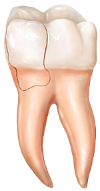Cracked Teeth
 Some common types of cracks are superficial and require no intervention while other cracks can eventually lead loss of your tooth. A cracked tooth can cause a wide variety of symptoms. The movement along the crack irritates the nerve of the tooth. If cracks and fractures are left untreated they can allow bacteria from your saliva to penetrate the tooth and cause infection.
Some common types of cracks are superficial and require no intervention while other cracks can eventually lead loss of your tooth. A cracked tooth can cause a wide variety of symptoms. The movement along the crack irritates the nerve of the tooth. If cracks and fractures are left untreated they can allow bacteria from your saliva to penetrate the tooth and cause infection.
At Modern Endo of Napa we will thoroughly evaluate your tooth to determine if endodontic treatment is necessary. Sometimes a fractured tooth will only need the added protection of a crown, which would be done by your dentist.
There is wide variation in cracked teeth with each one given the patient different symptoms. You may experience erratic pain when chewing, pain on release of biting, or pain when your tooth is exposed to extreme temperatures. The pain may come and go. In the early stages there may be difficulty in locating which tooth is causing the discomfort. Larger cracks become easier to locate. If you think you are experiencing a cracked tooth discuss it with your dentist. If he/she suspects a cracked tooth you will likely be referred to Modern Endo of Napa for a detailed consultation using microscope and CBCT to determine your treatment options.
Surgical Operating Microscope:
In addition to digital radiography, we utilize special operating microscopes. Magnification and illumination are helpful in aiding the doctor to see tiny details inside your tooth, including fractures. Also, a camera on the microscope can record images of your tooth to further document the doctor’s findings.
Cone Beam CT 3-Dimensional Imaging:
This new technology allows complete 3D visualization of the teeth and bone with ultra low radiation exposure. While not used in every case, when it is needed it can provide unmatched diagnostic information. If a fracture is too small to be seen on the CT Scan, Dr. Tigrett can still use the CT Scan identify other clues that will help determine if your tooth is fractured. This allows us to make the most accurate treatment planning decisions before we ever start working on your tooth.
It is especially important that you call your restorative dentist as soon as possible to make your follow-up appointment. With a fractured tooth, it is recommended that you have a crown placed very soon, less than 4 weeks, after root canal treatment. This step is imperative for the long-term prognosis of your tooth as the crown will help to stabilize the fracture.
Ryan Tigrett D.D.S. Diplomate, American Board of Endodontics
We would love to hear from you!
Phone: 707-265-7790
Fax: 707-265-7793
Email: info@endonapa.com
Se Habla Español.
|
3448 Villa Lane
Suite 101
Napa, CA 94558
|
Our Office Hours:
We are open five days a week. Monday to Friday from 8:00am to 5:00pm.
Proudly Serving The Cities of:
Napa CA Vallejo CA American Canyon CA Saint Helena CA
Sonoma CA Fairfield CA Benicia CA Calistoga CA
Santa Rosa CA Yountville CA




